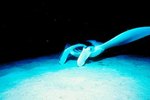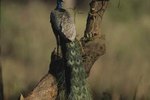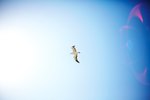
Horseshoe crabs (Limulus polyphemus) are invertebrates that aren't really crabs, despite their naming. Spiders are actually closer kin to horseshoe crabs than other crabs are, strangely enough. The "horseshoe" element of their moniker is a nod to the outline of their bodies, which are reminiscent of equine hooves. These primitive creatures, fascinatingly enough, have remained the same for 360 million years.
Spawning Season
Horseshoe crab spawning occurs on beaches in the springtime, as soon as the temperature of the water gets to 60 degrees Fahrenheit. Male horseshoe crabs are tinier than the females. They gather around the boundaries of the water in anticipation of spawning. Once the females appear, the males employ their claws to latch onto the shells of the fairer sex. After this happens, the females -- while lugging the males -- continuously stop each several feet or so to lay eggs, which the males promptly fertilize via giving off sperm. It isn't uncommon for other males that aren't connected to the females to simultaneously make fertilization efforts, too.
Lots and Lots of Eggs
Female horseshoe crabs obscure parts of their bodies with sand as they lay their eggs. When the females carve out openings in the sand for their eggs, they often lay roughly 4,000 of them. These miniscule eggs are deep greenish in coloration. The females can lay numerous batches of eggs throughout single nights of spawning. If they continue to do so for strings of back-to-back nights, it sometimes results in the laying of a minimum of 100,000 eggs.
Horseshoe Crab Youngsters
Hatching generally takes between two weeks and a month. Once the youngsters leave the eggs, they head straight to the water. Horseshoe crab larvae are physically similar to the adults, although they lack tails and are significantly smaller. Youthful horseshoe crabs tend to take residence on mudflats.
Eggs as Food Supplies
Horseshoe crabs serve as a vital food item for a wide array of animals, specifically certain types of fish, young loggerhead sea turtles and shorebirds. White perch (Morone americana) and striped bass (Morone saxatilis) are two specific varieties of fish that frequently dine on these eggs. As far as birds go, sanderlings (Calidris alba) and red knots (Calidris canutus) both feed on these eggs. Crabs frequently dine on them, too. Many birds specifically adjust their migrating schedules so that they reach certain destinations right as horseshoe crab spawning is going on.
References
- Florida Fish and Wildlife Conservation Commission: Facts About Horseshoe Crabs
- U.S. National Park Service: Horseshoe Crabs
- Maryland Department of Natural Resources: Horseshoe Crabs
- U.S. Fish & Wildlife Service: The Horseshoe Crab
- Chesapeake Bay Program: Horseshoe Crab
- Smithsonian Environmental Research Center: Horseshoe Crab
- University of Michigan Animal Diversity Web: Limulus Polyphemus
- The IUCN Red List of Threatened Species: Limulus Polyphemus
Photo Credits
-
Hemera Technologies/AbleStock.com/Getty Images




